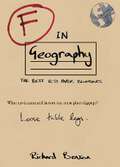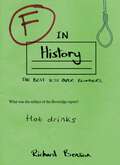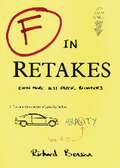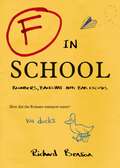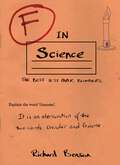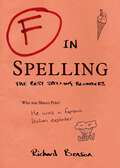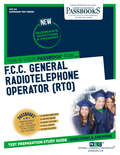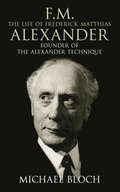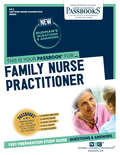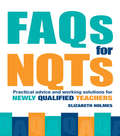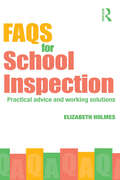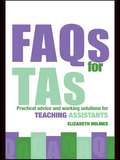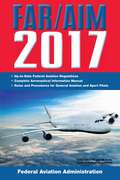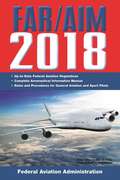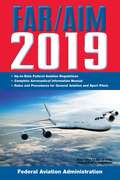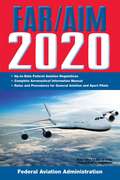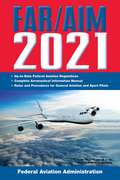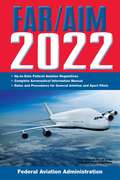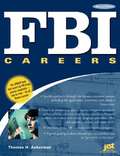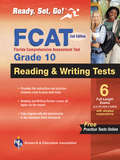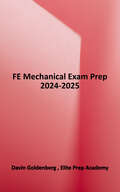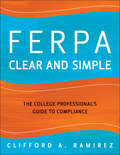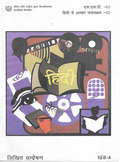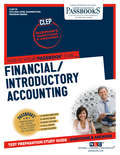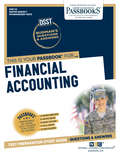- Table View
- List View
F in Geography (F In Exams Ser.)
by Richard BensonIf you get perspiration and precipitation confused, then take comfort in this hilarious, all-new, fun-size dose of F in Exams, containing some of the most cringeworthy howlers from school Geography exams.
F in History (F In Exams Ser.)
by Richard BensonIf you don’t know a cold war from a cold sore, then take comfort in this cracking, all-new, fun-size dose of F in Exams, containing some of the worst howlers from school history exams.
F in Retakes: Even More Test Paper Blunders (F In Exams Ser.)
by Richard BensonThe F in Exams are over, the results are in and just when you thought it was safe to go back in the classroom… BANG! It’s time for F in Retakes! Enjoy another heady dose of hilarious answers that canny students have given to the trickiest exam questions.
F in School: Blunders, Backchat and Bad Excuses (F In Exams Ser.)
by Richard BensonAhh, glorious school days… It’s no wonder they went so quickly with all the exams, the classroom fun, the sticky situations to get out of, the work to avoid and the teachers to annoy. Enjoy this new collection of hilarious exam answers, along with schoolyard jokes, amusing doodles, silly excuses, spelling slip-ups and loads more!
F in Science (F In Exams Ser.)
by Richard BensonIf the thought of science exams conjures up the memory of singeing your eyebrow on a Bunsen burner, then take comfort in this cracking, all-new, funsize dose of F in Exams, containing some of the most glorious howlers from school science exams.
F in Spelling: The Funniest Test Paper Blunders (F In Exams Ser.)
by Richard BensonWe all know that the written word is full of traps for the unwary, and this goes double for those in their early years of learning it. Enjoy this collection of side-splitting spelling slip-ups ranging from the charming to the ridiculous, and the cute to the unintentionally X-rated!
F.C.C. GENERAL RADIOTELEPHONE OPERATOR: Passbooks Study Guide (Admission Test Series)
by National Learning CorporationThe Admission Test Series prepares students for entrance examinations into college, graduate and professional school as well as candidates for professional certification and licensure. The F.C.C. General Radiotelephone Operator Passbook® prepares you by sharpening the skills and abilities necessary to succeed on your upcoming entrance exam. It provides hundreds of questions and answers in the areas that will likely be covered on your upcoming exam.
F.M.: Founder of the Alexander Technique
by Michael BlochThe Alexander Technique is a method of muscular re-education, which has become standard training for actors, dancers and singers, and is practised for health reasons all over the world. Its founder, Frederick Matthias Alexander (1869-1955), was an Australian actor who stumbled upon it in the 1890s after studying himself in mirrors to discover why he had lost his voice. He realised that most people suffered from the same postural defects he had noticed in himself, and that this explained much of what went wrong with them. F.M. (as he was known) came to London in 1904 and became enormously successful. During the First World War he practised in America with equal success, converting the American philosopher John Dewey to his cause. He wrote four books (all still in print), and his supporters included Aldous Huxley, George Bernard Shaw and Stafford Cripps. He was, however, a difficult and argumentative man who made enemies. Towards the end of his life he embarked on a libel action against the South African government, which had accused him of charlatanism. He won, and went on practising and propagating his technique until his death aged 86.
FAMILY NURSE PRACTITIONER: Passbooks Study Guide (Certified Nurse Examination Series)
by National Learning CorporationThe Certified Nurse Examination Series prepares individuals for licensing and certification conducted by the American Nurses Credentialing Center (ANCC), the National Certification Corporation (NCC), the National League for Nursing (NLN), and other organizations. The Family Nurse Practitioner Passbook® provides a series of informational texts as well as hundreds of questions and answers in the areas that will likely be covered on your upcoming exam.
FAQs for NQTs: Practical Advice and Working Solutions for Newly Qualified Teachers
by Elizabeth HolmesThis useful reference book offers authoritative yet accessible answers to common questions posed by new and trainee teachers as they face the practical everyday questions that arise from entering the classroom for the first time. Organized into sections the book covers issues such as: job hunting induction managing workload relationship building with pupils and colleagues dealing with parents other personal yet work-related issues. The issues covered are ones that have been highlighted through Elizabeth Holmes' work as an online agony aunt for teachers and her column 'Ask Elizabeth' on Eteach.com. Based on real questions with common themes this will be a welcome resource for any NQT.
FAQs for School Inspection: Practical Advice and Working Solutions
by Elizabeth HolmesSchool inspections still have the potential to spread fear and panic through even the best-run schools, but this practical book will remove all of the anxiety, with its proven advice to help ensure a successful inspection. Ideal for all teachers, whether newly qualified or with decades of experience, FAQs for School Inspection will guide the reader calmly through the pre- and post-inspection stages, offering valuable insights into what can happen during the inspection itself. Covering recent legislative changes and everything to do with school inspection, it outlines the teacher/inspector relationship and gives advice on coping with the potential stresses of inspections. Organised into logical sections, the book covers issues such as preparing for inspection being inspection-aware the effects inspection has on you personally what happens after inspection. Complete with advice on using inspection to further personal and professional development, this ready-reference guide will allow teachers to play a confident and influential role in school inspection.
FAQs for TAs: Practical Advice and Working Solutions for Teaching Assistants
by Elizabeth HolmesFAQs for TAs is a friendly and accessible guide covering the core questions that both new and existing teaching assistants may have about their jobs. Arranged in question and answer format, it covers all the essential information that teaching assistants need to know in an easily accessible book. It includes: the themes of becoming a teaching assistant (training and funding possibilities, finding vacancies and getting through the selection process) what the job entails getting started, managing workload dealing with behaviour working with colleagues. Differing from others on the market in that it focuses specifically on the core ‘need to know’ items for TAs, this book is authoritative and reassuring - delivering exactly what TAs need to help them on the job. It also explores areas of possible future development and career progression combined with sources of further information.
FAR/AIM 2017: Federal Aviation Regulations / Aeronautical Information Manual (Far/aim Ser.)
by Federal Aviation AdministrationLearn to fly a plane according to Federal Aviation Administration (FAA) regulationsThe most complete guide to the rules of aviation accessible anywhere Contains all of the information needed to operate safely in US airspace and is fully updatedIf you are an aviation enthusiast or an aviator, you need to have the newest edition of the FAR/AIM. In the most recent edition of the FAR/AIM, produced by the FAA, all procedures, illustrations, and regulations are up-to-date and reflect current FAA data. Learn about takeoffs and landings, land navigation, how to aid climb, world flight patterns, flying rolls, academic liftoff, and more. This useful reference book is a critical resource for all members of the aviation community, including aspiring pilots seeking a concrete background in the rules, procedures, and requirements of flight training. This manual also includes: A study guide for specific pilot training certifications and ratingsStandard instrument proceduresA pilot/controller glossaryParachute operationsThe NASA Aviation Safety reporting formAirworthiness standards for products and partsImportant FAA contact information
FAR/AIM 2018: Federal Aviation Regulations And Aeronautical Information Manual (includes Changes 1 And 2) (FAR/AIM Federal Aviation Regulations)
by Federal Aviation AdministrationAll the information you need to operate safely in US airspace, fully updated.If you’re an aviator or aviation enthusiast, you cannot be caught with an out-of-date edition of the FAR/AIM. In today’s environment, there is no excuse for ignorance of the rules of the US airspace system. In the newest edition of the FAR/AIM, all regulations, procedures, and illustrations are brought up to date to reflect current FAA data. This handy reference book is an indispensable resource for members of the aviation community, as well as for aspiring pilots looking to get a solid background in the rules, requirements, and procedures of flight training. Not only does this manual present all the current FAA regulations, it also includes:A study guide for specific pilot training certifications and ratingsA pilot/controller glossaryStandard instrument proceduresParachute operationsAirworthiness standards for products and partsThe NASA Aviation Safety reporting formImportant FAA contact informationThis is the most complete guide to the rules of aviation available anywhere. Don’t take off without the FAR/AIM!
FAR/AIM 2019: Up-to-date Faa Regulations / Aeronautical Information Manual (FAR/AIM Federal Aviation Regulations)
by Federal Aviation AdministrationAll the information you need to operate safely in US airspace, fully updated.If you’re an aviator or aviation enthusiast, you cannot be caught with an out-of-date edition of the FAR/AIM. In today’s environment, there is no excuse for ignorance of the rules of the US airspace system. In the newest edition of the FAR/AIM, all regulations, procedures, and illustrations are brought up to date to reflect current FAA data. This handy reference book is an indispensable resource for members of the aviation community, as well as for aspiring pilots looking to get a solid background in the rules, requirements, and procedures of flight training. Not only does this manual present all the current FAA regulations, it also includes:A study guide for specific pilot training certifications and ratingsA pilot/controller glossaryStandard instrument proceduresParachute operationsAirworthiness standards for products and partsThe NASA Aviation Safety reporting formImportant FAA contact informationThis is the most complete guide to the rules of aviation available anywhere. Don’t take off without the FAR/AIM!
FAR/AIM 2020: Up-to-Date FAA Regulations / Aeronautical Information Manual (FAR/AIM Federal Aviation Regulations)
by Federal Aviation AdministrationAll the Information you Need to Operate Safely in US Airspace, Fully Updated If you&’re an aviator or aviation enthusiast, you cannot be caught with an out-of-date edition of the FAR/AIM. In today&’s environment, there is no excuse for ignorance of the rules of the US airspace system. In the newest edition of the FAR/AIM, all regulations, procedures, and illustrations are brought up to date to reflect current FAA data. This handy reference book is an indispensable resource for members of the aviation community, as well as for aspiring pilots looking to get a solid background in the rules, requirements, and procedures of flight training. Not only does this manual present all the current FAA regulations, it also includes: A study guide for specific pilot training certifications and ratingsA pilot/controller glossaryStandard instrument proceduresParachute operationsAirworthiness standards for products and partsThe NASA Aviation Safety reporting formImportant FAA contact informationThis is the most complete guide to the rules of aviation available anywhere. Don&’t take off without the FAR/AIM!
FAR/AIM 2021: Up-to-Date FAA Regulations / Aeronautical Information Manual (FAR/AIM Federal Aviation Regulations)
by Federal Aviation AdministrationAll the Information you Need to Operate Safely in US Airspace, Fully Updated If you&’re an aviator or aviation enthusiast, you cannot be caught with an out-of-date edition of the FAR/AIM. In today&’s environment, there is no excuse for ignorance of the rules of the US airspace system. In the newest edition of the FAR/AIM, all regulations, procedures, and illustrations are brought up to date to reflect current FAA data. This handy reference book is an indispensable resource for members of the aviation community, as well as for aspiring pilots looking to get a solid background in the rules, requirements, and procedures of flight training. Not only does this manual present all the current FAA regulations, it also includes: A study guide for specific pilot training certifications and ratingsA pilot/controller glossaryStandard instrument proceduresParachute operationsAirworthiness standards for products and partsThe NASA Aviation Safety reporting formImportant FAA contact informationThis is the most complete guide to the rules of aviation available anywhere. Don&’t take off without the FAR/AIM!
FAR/AIM 2022: Up-to-Date FAA Regulations / Aeronautical Information Manual (FAR/AIM Federal Aviation Regulations)
by Federal Aviation AdministrationAll the Information You Need to Operate Safely in US Airspace, Fully Updated If you&’re an aviator or aviation enthusiast, you cannot be caught with an out-of-date edition of the FAR/AIM. In the newest edition of the FAR/AIM, all regulations, procedures, and illustrations are brought up to date to reflect current federal regulations and FAA data, policies, and advisories. This handy reference book is an indispensable resource for members of the aviation community, as well as for aspiring pilots looking to get a solid background in the rules, requirements, and procedures of flight. Not only does this manual present current FAA information, it also includes: A guide for specific pilot training certifications and ratingsA pilot/controller glossaryStandard instrument proceduresParachute operationsAirworthiness standards for aircraft and partsFlight and pilot school informationImportant FAA contact detailsThis is the most complete guide to the rules of aviation available anywhere. Don&’t take off without the FAR/AIM!
FBI Careers: The Ultimate Guide to Landing a Job as One of America's Finest (2nd edition)
by Thomas H. AckermanFBI Careers is the only definitive guide to the organization's rigorous selection process. Its helpful information reveals what it takes to succeed in landing a job - for special agents as well as professional support personnel.
FCAT Grade 10 Reading and Writing 2nd Ed.
by F. BanuEvery tenth grade student in Florida must pass the FCAT... Are you ready for the FCAT Reading and Writing Exams? REA's FCAT Reading and Writing test prep with bonus online tests helps you sharpen your skills and pass these exams! This second edition of our popular test prep provides the up-to-date instruction and practice that tenth grade students need to improve their reading and writing skills and pass these two state-required exams. The comprehensive review features student-friendly, easy-to-follow lessons and examples that reinforce the key concepts tested on the FCAT Reading and Writing exams, including: * Vocabulary * Literary analysis * Drafting * Revising Focused lessons explain reading and writing principles in easy-to-understand language that's suitable for tenth grade students at any learning level. Our tutorials and targeted drills increase comprehension while enhancing your skills. Color icons and graphics throughout the book highlight must-know concepts. Test-taking tips and strategies in each chapter give you an added boost of confidence so you can do your best on the exam. Six practice exams help you prepare for the FCAT! The book contains four full-length practice exams (two reading and two writing) that allow you to test your knowledge while reinforcing what you have learned. Two additional reading practice tests not found in the book are available online - for a total of six exams! Each practice test comes complete with detailed explanations of answers, allowing you to focus on areas in need of further study. Whether used in a classroom, for home or self study, or with a tutor, this test prep gets students ready for the FCAT Reading and Writing exams, set to take on new challenges, and helps them go forward in their studies! This book is a "must-have" prep for anyone taking the FCAT.
FE Mechanical Exam Prep: The Most Complete And Practical Study Guide To Get Ready For The Current Exam In 2 Weeks And Pass It On First Try (1000+ Ncees Aligned Practice Problems Included)
by Elite Prep Academy Davin GoldenbergGet Ready for The Fe Mechanical Exam in 2 Weeks and Pass It On First Try Do you want to get to the exam day with the confidence to pass on the first try, stand out from your peers, and secure your best future as a licensed engineer? The Elite Prep Academy Finally Makes Public the Ultimate ALL-IN-ONE Guide that Has Already Enabled Thousands of Aspiring Licensed Professionals Securing a Stable and Fulfilling Engineer’s Career - If You Fail the Fe Mechanical Exam On First Attempt Your Chances To Pass It On Second Try Drop Down To 35% - According to the National Council of Examiners for Engineering and Surveying, the average FE Exam pass rate is 71%, but it drops incredibly down to 35% for those retaking the exam a second time! - This suggests that failing the FE exam will get you caught in a vicious circle of repeated attempts and failures from which it will be really difficult to break free, thus making it vital to pass on first try - That’s why the Elite Prep Academy with the help of one of the most successful exam coaches David Goldberg, created the FE Mechanical Exam Prep study guide, the most complete and practical study guide to get ready for the FE mechanical exam in 2 weeks and pass it on your first try In This Fully Updated Guide, You’ll Get: - The Most Detailed FE Mechanical Exam Review - Complete Break-Down of Every Exam’s Knowledge Area - NCEES Handbook Aligned Topics, Formulas and Principles - Detailed Explicative Graphics, Tables and Diagrams - Effective Strategies to Master the NCEES Handbook Navigation - The Most Complete FE Mechanical Exam Practice - 1000+ NCEES Aligned Practice Problems and Answers - Real-Life Exam Experience to Boost Your Improvement - Complete Practice for All the Exam Knowledge Areas - Adaptable and Motivating 2 Weeks Study Plan - Access to Our NCEES Aligned Private Platform - FE Mechanical Key Video Lessons - FE Mechanical Problems & Answers - FE Mechanical Printable Flashcards
FERPA Clear and Simple
by Ramirez Clifford A.Family Educational Rights and Privacy Act (FERPA) compliance has always been challenging due to complex regulatory language and exposure to risk. However, institutions that do not comply are in jeopardy of losing federal funding. Accessible and user-friendly, FERPA Clear and Simple clarifies the regulations and provides a ready reference for compliance and problem solving. This need-to-have guide offers critical and relevant material (including the 2008 Amendments) from a new perspective to help staff in student affairs, academic departments, and administrative support positions understand and comply with FERPA guidelines.
FHD - 02 Hindi Me Aadhar Pathyakram - Khand 1 Bhasha Aur Sampreshan - IGNOU: FHD - 02 हिंदी में आधार पाठ्यक्रम - खंड 1: लिखित सम्प्रेषण - इग्नू
by Indira VishvavidyalayaFHD-02 हिंदी में आधार पाठ्यक्रम (खंड 1: भाषा और सम्प्रेषण) – इग्नू यह किताब इंदिरा गांधी राष्ट्रीय मुक्त विश्वविद्यालय ने हिंदी भाषा में प्रकाशित किया है । हिंदी में आधार पाठ्यक्रम-02 (एफ.एच.डी.02) का यह पहला खंड है इस खंड में छह इकाइयाँ हैं । इस खंड में भाषा और सम्प्रेषण पर विचार किया गया है। सम्प्रेषण के क्रम में हम भाषा का विभिन्न स्तरों पर उपयोग करते हैं। सम्प्रेषण मुख्य रूप से बोलकर और लिखकर किया जाता है। इसके अलावा हम अपने शारीरिक अंगों के माध्यम से भी अपने भावों को प्रकट करते हैं। इसे उच्चरित भाषा, लिखित भाषा और आंगिक भाषा के नाम से जाना जाता है। इन तीनों भाषिक अभिव्यक्तियों पर हमने अलग अलग इकाइयों में विचार किया है।
FINANCIAL ACCOUNTING: Passbooks Study Guide (College Level Examination Program Series (CLEP) #Dantes-15)
by National Learning CorporationThe College Level Examination Program (CLEP) enables students to demonstrate college-level achievement and earn college credit in various subject areas based on knowledge acquired through self-study, high school and adult courses, or through professional means. The CLEP Financial Accounting Passbook® prepares you by sharpening knowledge of the skills and concepts necessary to succeed on the upcoming exam and the college courses that follow. It provides a series of informational texts as well as hundreds of questions and answers in the areas that will likely be covered on your upcoming exam, including but not limited to: general accounting principles and practices; the income statement; the balance sheet; and more.
FINANCIAL ACCOUNTING: Passbooks Study Guide (DANTES Subject Standardized Tests (DSST) #Dantes-15)
by National Learning CorporationThe DSST Subject Standardized Tests are comprehensive college and graduate level examinations given by the Armed Forces, colleges and graduate schools. These exams enable students to earn college credit for what they have learned through self-study, on the job, or by other non-traditional means. The DSST Financial Accounting Passbook® prepares candidates for the DSST exam, which enables schools to award credit for knowledge acquired outside the normal classroom environment. It provides a series of informational texts as well as hundreds of questions and answers in the areas that will likely be covered on your upcoming exam.
